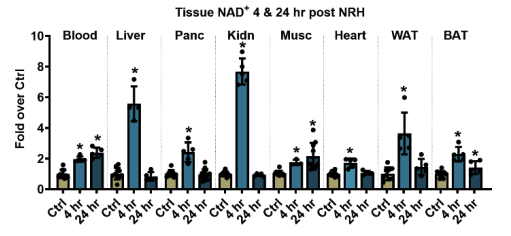This study evaluated the metabolism, safety, and therapeutic potential of a novel NAD+ precursor, dihydronicotinamide riboside (NRH), in lean and obese mice.
Key Points:
Several significant findings about NRH were uncovered in the study:
- NRH administered via IP injection easily enters cells and rapidly converts to NMNH, significantly increasing tissue NAD+ levels.
- Repeated NRH injections maintain elevated NAD+ levels above baseline.
- Glucose regulation and insulin sensitivity were restored.
- Blood fats, fat tissue function, and distribution improved, with a reduction in fat mass.
- Cholesterol storage in the liver increased, contributing to reduced blood cholesterol levels.
- Increased NAD+ activated sirtuins and enhanced mitochondrial function.
Metabolism and Efficacy of NRH Injections Evaluated in Lean and Obese Mice
Researchers conducted two studies in mice to evaluate how NRH is processed and its potential therapeutic benefits.
Study 1: Examined how a single injection (IP) of PBS (placebo) or NRH (250 mg/kg) was absorbed and affected tissues.
- Blood samples were collected over a 4-hour period to track how NRH moved through the body.
- Tissue samples were taken 30 minutes after injection to evaluate the drug’s effect on different organs.
Study 2: Tested NRH’s therapeutic benefits in mice fed either a regular diet or a high-fat diet for three months, then divided into two treatment groups:
- Placebo Group: Received injection of PBS (IP, 3x/week for 7 weeks).
- NRH Group: Received 250 mg/kg of NRH by injection (IP, 3x/week for 7 weeks).
NRH Rapidly Enters Cells and Increases NAD+, with Strong Effects in the Pancreas
Following injection, NRH was rapidly absorbed into the bloodstream, reaching peak levels within 5 minutes and then quickly disappearing within an hour.
NMNH, a key intermediate molecule, appeared within 30 minutes and persisted in the bloodstream for a longer duration.

The graph shows how NRH and NMNH levels changed over 4 hours following the NRH injection. The yellow line shows NRH’s sharp rise and quick clearance within 60 minutes, while the green line shows NMNH rising higher and remaining in the bloodstream well after NRH has disappeared.
NRH was rapidly converted into NMNH in tissues.
“NRH levels were relatively low, while NMNH was abundant, suggesting rapid phosphorylation.”
This metabolic process led to higher NAD+ levels in tissues, with the pancreas showing the most pronounced effect – NAD+ increased 5.3-fold.
“NAD+ levels were also significantly increased, indicating efficient downstream conversions.”
“The pancreas showed the highest NMNH concentration and 5.3-fold increase in NAD+.
NRH was also detected in the brain, suggesting it crosses the blood-brain barrier.
“Notably, NRH increased in the brain, suggesting it can cross the blood-brain barrier.”
Sustained NAD+ Elevation and Improved Body Composition
NRH injections (3x/week for 7 weeks) maintained elevated NAD+ levels throughout the study:
- Healthy mice: 1.5x higher than controls.
- Obese mice: 1.8 to 1.9x higher than controls.
Body composition improved without changes in diet, activity, or energy use:
- Healthy Mice: Lean mass increased slightly, and fat mass decreased.
- Obese Mice: Less weight gain and increased lean mass.
NRH treatment was well-tolerated with no signs of toxicity.
Restored Blood Sugar Regulation in Obese Mice
After three weeks, NRH injections significantly improved blood glucose (sugar) regulation and insulin sensitivity in obese mice.
Key Improvements:
- Improved Blood Sugar Control: Lowered fasting blood sugar and increased the rate of glucose clearance after sugar intake.
- Enhanced Insulin Function: Increased pancreatic insulin secretion and insulin sensitivity in tissues.
- Increased Insulin Production: More insulin-producing cells in the pancreas.
- Reduced Liver Glucose Production: Suppressed gluconeogenesis (liver sugar production).
“Together, these findings suggest NRH improves glucose homeostasis through multiple tissues and mechanisms in obese mice.”
Improved Blood Cholesterol and Fat Tissue Function
Three weeks of NRH in obese mice lowered total cholesterol, LDL (“bad” cholesterol), HDL (“good” cholesterol), and triglycerides – a blood fat that can raise heart disease risk when high.
NRH also reduced body fat and improved fat tissue function.
“These data demonstrate NRH reduces lipid deposition in WAT and BAT while improving adipose function in obese mice.“
NRH increased liver size by 20%, but no liver damage was observed.
“One unexpected finding here was that NRH increased liver weight in DIO mice.”
Cholesterol storage in the liver increased, primarily as cholesteryl esters (CE), contributing to lower blood cholesterol.
“The majority of lipid species increased by NRH are CE, which were associated with changes in serum cholesterol levels.”
NRH promoted the uptake of “good” cholesterol (HDL) by the liver and decreased the production of cholesterol-carrying particles (VLDL), further lowering blood cholesterol.
“We deduce that NRH increases hepatic CE storage by enhancing HDL-C uptake and suppressing VLDL-C release, leading to reduced circulating cholesterol.”
“Overall, these findings confirmed NRH treatment mobilizes lipid storage, improving adipose function and reducing ectopic TG deposition, except for increased liver TG and CE storage.”
NAD+ Activation of Sirtuins Improved Mitochondrial Function
In lean mice, only the pancreas showed increased NAD+ levels 24 hours after the last NRH injection.
In obese mice, the NAD+ response varied:
- NAD+ levels in the liver, pancreas, kidney, heart, and fat peaked 4 hours after injection and returned to normal within 24 hours.
- NAD+ in blood, muscle, and brown fat (BAT) remained elevated for 24 hours.

This figure shows NAD+ levels in the tissues of obese mice 4- and 24-hours after the final NRH injection. NAD+ levels in the liver, pancreas, kidney, heart, and fat (WAT) peaked 4 hours after injection, while NAD+ in the blood, muscle, and brown fat (BAT) stayed elevated for 24 hours post-injection.
“These findings indicate NRH potently replenishes NAD+ levels after repeated administration, though the increases are more transient in splanchnic tissues compared to peripheral tissues.”
Higher NAD+ levels promoted sirtuin activation (SIRT proteins), critical enzymes for cell health.
Specifically, activation of SIRT3 in the mitochondria improved antioxidant defenses and enhanced energy production.
“Mitochondrial SIRT3 targets, superoxide dismutase 2 (SOD2) and mitochondrial isocitrate dehydrogenase (IDH2), were both increased in NRH-treated livers, suggesting improved antioxidant defense to combat excessive oxidative stress.”
Conclusion
NRH injections are efficiently absorbed by cells and rapidly converted into NMNH, significantly increasing NAD+ levels in tissues.
“These results demonstrate NRH freely passes cell membranes, likely via passive diffusion, and is rapidly metabolized for NAD+ biosynthesis.”
The pancreas showed the strongest response, with NMNH levels rising the highest and NAD+ increasing 5.3-fold.
“A significant observation was NRH’s targeted effects on the pancreas, enhancing insulin secretion and pancreatic insulin content.”
NRH improved blood sugar regulation and insulin sensitivity through multiple pathways, aligning with the elevated NAD+ production in the pancreas.
“This aligns with the highest NMNH and NAD+ production observed in the pancreas following NRH injection.”
In obese mice, NRH reduced fat mass and improved fat distribution, blood lipid profiles, and fat tissue function.
By raising NAD+ levels, NRH activated sirtuins, including SIRT3, improving mitochondrial function and antioxidant defenses.
“These benefits were linked to elevated tissue NAD+ levels, enhanced Sirtuin activities, and increased mitochondrial antioxidant defenses.”
“To our knowledge, this is the first report showing that NRH can reach multiple tissues intact and provide a broad spectrum of effects through potent NAD+ enhancement and subsequent SIRT activation.”
